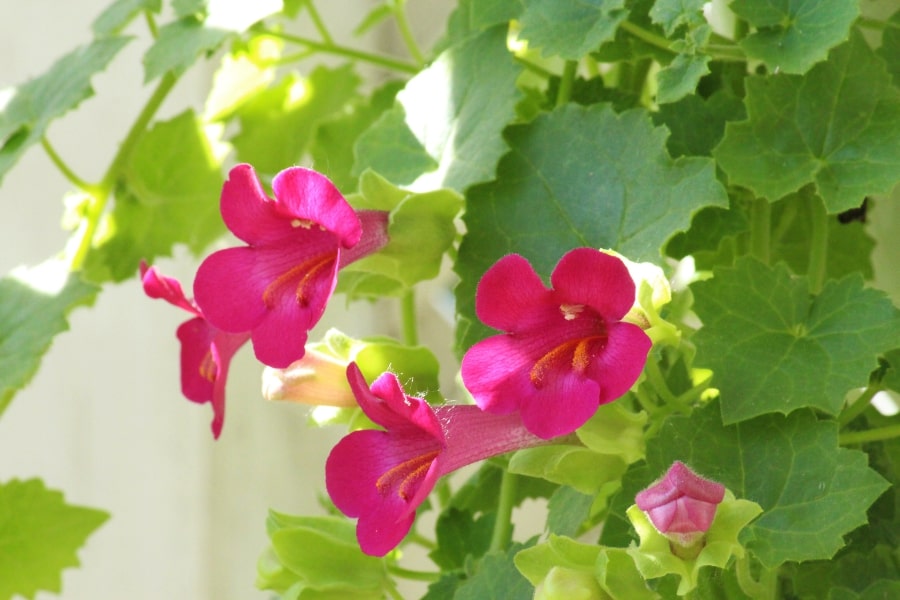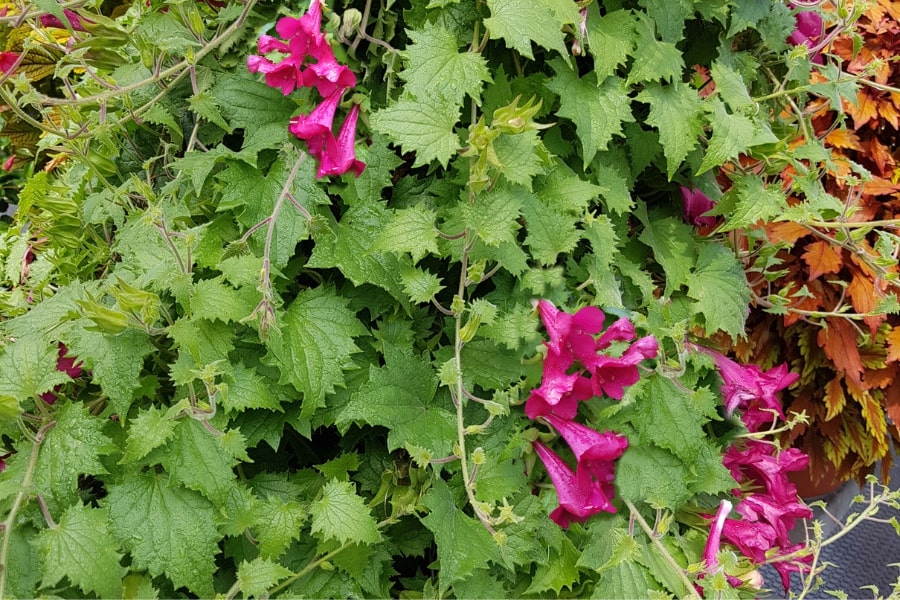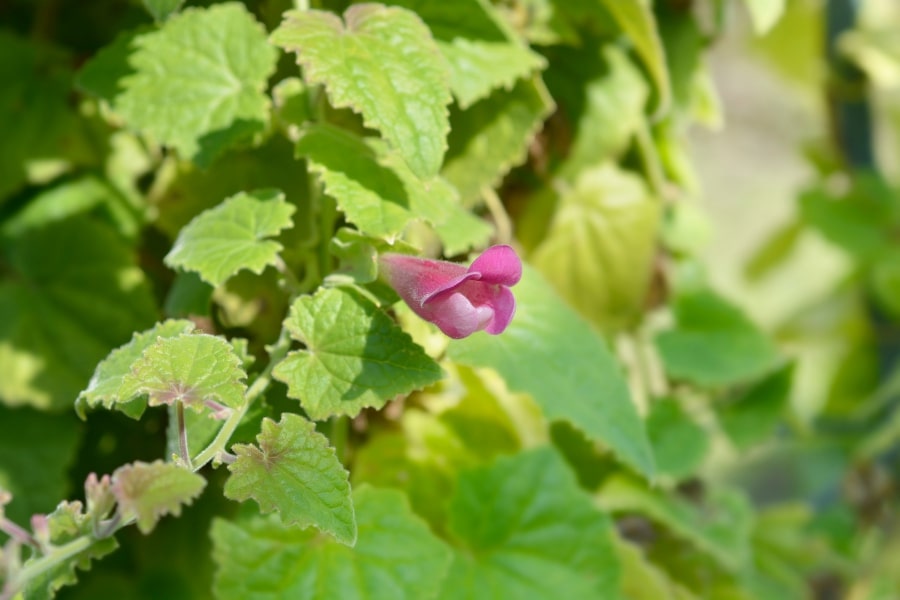Lophospermum, commonly known as the “Creeping Gloxinia” or “Lophospermum Vine,” is a genus of flowering plants in the family Plantaginaceae. Native to Mexico and Central America, Lophospermum species are known for their vigorous growth habits, attractive foliage, and showy trumpet-shaped flowers. Lophospermum plants are strong climbers that can reach heights of 6 to 10 feet (1.8 to 3 meters) or more, depending on the variety and growing conditions. They have a sprawling growth habit, with long, slender stems that twine and climb their way up trellises, arbors, or other support structures.

Our Selection of Lophospermum
At Martin Garden Center, we love Lophospermum. This climbing, cascading, twining vine is the bomb. A perfect part-sun to full shade plant with gorgeous color. This little cutie won’t be available till Mid to Late-April and once we’re done, we’re done.
In 2025, we are growing three varieties of Lophospermum:
- Lofos Compact Rose
- Lofos Compact White
- Lofos Wine Red
All of our Lophospermum are destined for 10″ hanging baskets including some combos. Lophospermum can’t be grown in 4″ because they attack each other. They vine quickly and they twine quickly, but they are excel in hanging baskets.
Growing and Caring For Lophospermum
- Sunlight and Location: Lophospermum thrives in full sun to partial shade. When selecting a location for planting, choose an area that receives at least 6 hours of sunlight per day. If you’re growing Lophospermum indoors, place it near a sunny window where it can receive bright, indirect sunlight throughout the day. Adequate sunlight is essential for promoting healthy growth and abundant flowering.
- Soil and Watering: Lophospermum prefers well-draining soil that is rich in organic matter. Amend the soil with compost before planting to improve its fertility and drainage. Water the plants regularly, keeping the soil evenly moist but not waterlogged. Allow the top inch of soil to dry out slightly between waterings to prevent overwatering, which can lead to root rot. Mulching around the base of the plant can help retain moisture and suppress weeds.
- Support and Pruning: Lophospermum is a climbing vine that requires support to grow upward. Provide a sturdy trellis, arbor, or other support structure for the plant to climb on. As the vine grows, gently train it to climb along the support structure using soft ties or twine. Regular pruning is essential for maintaining the plant’s shape and promoting bushy growth. Prune back any leggy or straggling stems and dead or diseased growth to encourage new growth and flowering.
- Fertilizing: Fertilize Lophospermum plants regularly throughout the growing season to promote healthy growth and flowering. Use a balanced, water-soluble fertilizer formulated for flowering vines, following the manufacturer’s instructions for application rates and frequency. Avoid overfertilizing, as excessive fertilizer can cause salt buildup in the soil and lead to nutrient imbalances. Instead, apply fertilizer sparingly and evenly to ensure balanced growth and vibrant flowering.
- Overwintering and Protection: Lophospermum plants may be treated as annuals or overwintered indoors in cooler climates to protect them from frost and freezing temperatures. Before the first frost, bring container-grown plants indoors to a cool, bright location, such as a greenhouse or sunny window. Alternatively, take stem cuttings from outdoor plants to propagate new plants for the following growing season. Provide adequate protection for outdoor plants by covering them with frost cloth or bringing them indoors during periods of extreme cold.
Leaves and Flowers
The foliage of Lophospermum plants is typically heart-shaped or ovate, with serrated edges and a rich green color. The leaves are arranged alternately along the stems, providing a lush backdrop for the plant’s vibrant flowers. Lophospermum flowers are trumpet-shaped and come in various colors, including shades of pink, purple, red, and white. The flowers are borne in clusters at the tips of the stems and bloom profusely from late spring to early fall, attracting pollinators such as bees and butterflies to the garden.

Uses in the Garden
Lophospermum is a versatile plant that can be used in a variety of ways to enhance garden landscapes and outdoor spaces. Climbing varieties are perfect for covering trellises, arbors, or pergolas, where they provide vertical interest and a burst of color throughout the growing season. Trailing varieties are well-suited for hanging baskets, window boxes, or containers, where they spill over the edges and create a cascading effect. Lophospermum can also be planted as ground covers to fill bare spots or provide erosion control on slopes or hillsides.
These charming vines are excellent additions to mixed borders, where they can be paired with other flowering perennials or shrubs to create a vibrant tapestry of colors and textures. They also make attractive accents in foundation plantings or along garden paths, where their lush foliage and colorful flowers add visual interest and curb appeal. Whether grown as climbers, trailers, or ground covers, Lophospermum plants will make a stunning statement in any garden or landscape setting.

Frequently Asked Questions
Is Lophospermum Poisonous To Dogs?
Lophospermum, also known as the Creeping Gloxinia or Lophospermum Vine, is not listed as toxic to dogs.
Can I Grow Lophospermum Indoors?
While Lophospermum plants prefer outdoor conditions with ample sunlight, they can be grown indoors in bright, sunny locations. Provide them with a sturdy support structure such as a trellis or stake, and ensure they receive adequate light and moisture.
Is Lophospermum Invasive?
Lophospermum plants can be vigorous growers, especially in favorable growing conditions. While they are not typically considered invasive, they may spread quickly if not properly contained or pruned.
